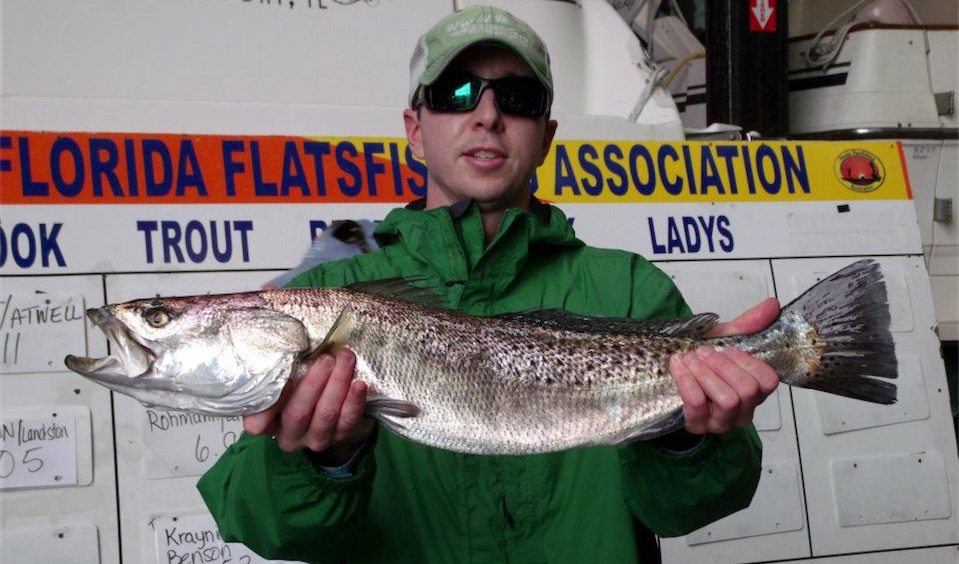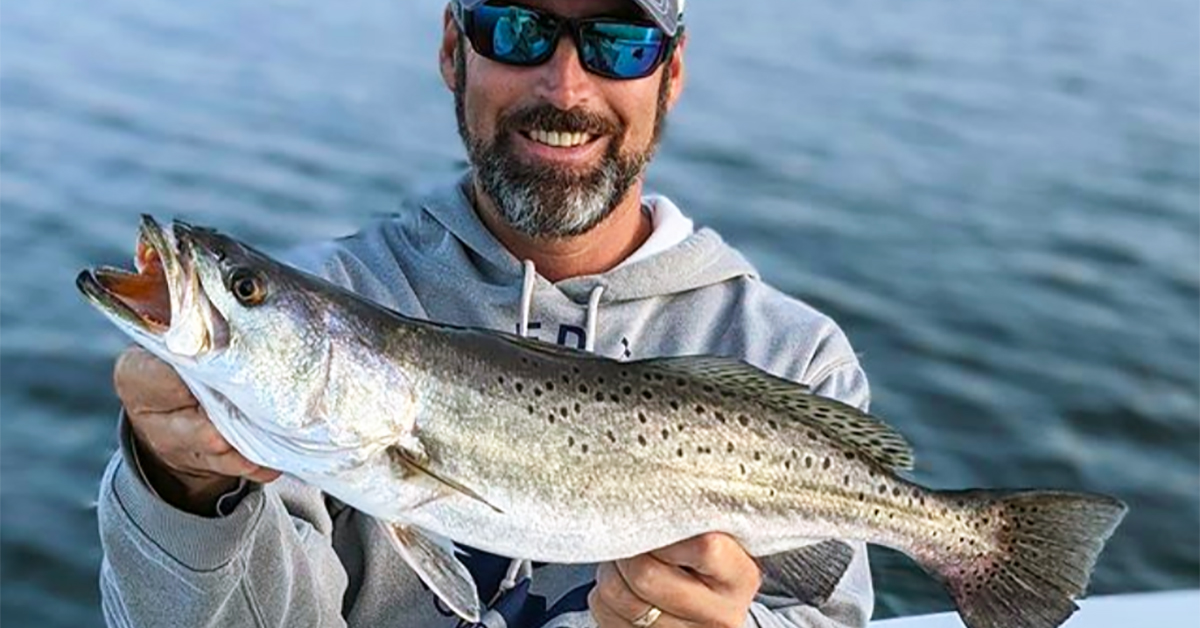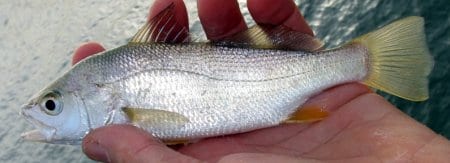Speckled Trout Slot Limit Florida
A burgeoning population of big trout on the east coast puts a trophy in reach of every fly caster.
I heard the pop a fraction of a second before I felt the strike. Had I waited for the line to come tight, I’m sure I would have missed another fish. I ran my stripping hand back to my hip, and the line slid out of my fingers like the leash of a bolting dog.
Man, I just love the sound of a fly reel, I thought. It’s like a favorite song being played live, with a different rhythm each time. You know the basic tempo, but have to adapt your dance to the new tune. Hope this one ends better than the rest.
The fish took at least a hundred feet of backing, swinging in a wide arc before heading back to its original position on top of the bar. I strained to keep up with the fish on the little 6-weight reel, spinning the handle haphazardly in an effort to gain line.
I’m successful at finding and catching trout, but on a typical trip I’m catching approx. 15 fish around 13″ and only five or so within the Florida slot limit all out of the same spot or school. Do you have any tips for consistently finding larger trout? I know gator trout are less common but I’d like to up the average trout I catch. The average trout caught in our area will be in the lower end of the 15-20 inch slot limit, but there are days when numerous fish are landed over the 20 inch slot. No matter the size, there is nothing more exciting than seeing a hefty sea trout thrash its golden mouth on the surface, just after eating your topwater lure. The 18 to 27 inch slot limit on Florida redfish was not changed. In the case of sea trout, limits have been upped from 5 fish to 6 fish. The closure of the speckled sea trout season during the month of February has also been put to an end. The Northeast Region would enjoy Florida’s most liberal limit at 5-fish plus one allowed over 20 inches. The Southeast Region, on the other hand, would receive the greatest restriction, with just a.

One nice thing about fly lines is that the diameter of the line creates so much friction that there’s never any real slack given to the fish. Had I made such a feeble attempt on monofilament, the fish would have probably spit the hook.

Fortunately, that wasn’t the case, and the big trout came to my feet shaking its head on the surface in a last-ditch effort to rid its upper lip of the chartreuse Dahlberg Diver.
So big was the fish’s girth that two tries to get my hand around its shoulders and maintain control so I could retrieve my fly left me with one fish-slimed finger. I made a mental note to bring along a landing net on future trips.
Speckled Trout Slot Limit Florida Keys
That’s the way it works when you’re fishing in complete darkness. It was also the sacrifice that needed to be made if I was going to get a shot at a big trout that morning. Sure, I could have waited for the false dawn to light the horizon and add a little depth of field to the background, but by then, I’d be lucky to have one or two shots at a decent trout before the rising sun allowed the fish a substantial look at the fly.
At five in the morning, the tide pushed enough water on top of the small Indian River spoil island that the largest trout in the river were now up in the shallows searching for a mullet meal. All I had to do was approach the fish quietly, and try to work the fly over the bar without being able to see any part of the operation.
Braille fishing I call it. Using the other five senses to work the fly out and back, without missing the attack of a feeding trout.
In the first hour, I blew two strikes from fish, one that yanked the fly line out of my hand at the beginning of a strip, and another that spit the fly before I could react with a long strip-strike. Both fish struck with authority, and I was determined not to lose another fish because of angler error.
This time, the hefty trout came to my feet on its side, and I was able to get my hand underneath its belly and maintain some semblance of control. After admiring the girth and depth of the obviously roe-laden fish, I removed the fly and set it free. It left with a slap of the tail, soaking my face and neck.
Back in the early ’80s big trout were a common catch in the stretch of Indian River between Vero Beach and Stuart, but overfishing put a noticeable dent in the population in less than a decade, and trout anglers went from targeting the gators on a regular basis to counting these large trout as incidental catches when after the schoolies. The problem with grouping the two is that the juveniles and adults prefer their own habitats.
Juvenile seatrout are covered with dark spots which give them added camouflage over dense grassbeds. Gator trout, on the other hand, are sparsely mottled with light brown spots, a coloration that proves beneficial over sandy bottom like that found on the pothole-dotted flats. Both gather in their distinct hunting grounds, yet adult trout remain one of the largest predators of juvenile trout, so the two do mingle. That’s possibly where the incidental catches of adult trout come in.
Anglers searching for school trout tend to work the flats in two to four feet of water, where they can present a small Clouser Deep Minnow or Borski Shrimp Fly, both of which have lead eyes to sink the fly through the water column and dance it like a jig.
Gator trout do the majority of their foraging in less than two feet of water, but when the food is scarce or the weather cool, they will move out to the deeper sections of the river to feed.
But things have changed for the better in the several short years since the implementation of the net-ban amendment. Juvenile trout are as abundant as ever, with anglers throughout the length of the historic river finding more 2- to 5-pound trout. Even the legendary Indian River gator trout population is on the rise.
That’s not to say fishing is as good as it was in the late ’70s and early ’80s, but it’s getting there. Between a 5-fish bag limit, 15- to 20-inch slot limit, with one trout allowed over 20 inches, the population of the species is starting a definite upswing.
I was fortunate to live on the river during the height of the seatrout’s popularity, and for many years the species was my fish of choice. Sadly enough, I contributed to the decline of the species by eating most of the large trout I caught, but it wasn’t long before the lack of fish and a little education taught me there were better food options out there and how a bit of conservation can vastly improve a large amount of fishing.
I still use all the tricks I learned when fishing for big trout, only I release all my trout, regardless of size these days, and it’s nice to see the fish showing the same patterns as in the old days.
Two of the first things I learned about big seatrout was that the fish come into the shallows to feed during low-light conditions, and that they have an excellent sense of hearing. While it’s easy to adjust your fishing schedule to accommodate the low light, remaining soundless in any boat is a work of art and a negligible proposition when fishing alone. Even with an angler poling the boat, the tip of a pushpole occasionally hitting rock or a portion of the platform sends enough noise through the water to put most large trout on their guard. That’s why I prefer to wade after large trout.
Wading presents a low angler profile above the water line, and limits the noise factor. Wading also adds a spiritual communion with the water and all its inhabitants, joining the angler with his prey and heightening the senses. It seems like I see and hear more movement and catch more big trout when on foot than when fishing out of a boat. Of course, that equation only applies to shallow-water fishing during the warm months. When the trout move into their deeper winter lairs, it’s the boating angler who finds the fish.
Since you’re trying to decrease the amount of noise you make, be sure not to take long stri
des that splash the water around your ankles or legs. The sound of an approaching angler is much different from that of a scampering baitfish, and trout can tell from 40 yards or more just what is happening around them.
Speckled Trout Slot Limit Florida
Often they are spooked when a trout pops a school of mullet just out of casting range and the angler rushes to get close enough to reach the last spot the fish struck. What usually happens is that the angler sets the fish on its guard by making too much noise closing the gap, or in the worst-case scenario, spooks the fish that has itself closed the distance by swimming at the angler.
Instead, make short steps, taking care to shuffle your feet to avoid stepping on any stingrays. Blind cast in the direction of the strike, and work the fly back. Many times, the sound or ripple of the fly will entice the trout closer to the angler.
Just as sound can be a hindrance to anglers and a defense for trout, it can also be turned against the fish to draw a trout to the fly or attract a strike. Surface flies that pop or produce a loud “bloop” similar to the noise made by an escaping mullet draw trout from 8 or 10 yards, and rattles added to a shrimp fly echo well through the entire water column.
The thing to remember about fly fishing for big trout is that the main forage for the species is large finfish, with a preference for mullet in the spring and fall, pinfish and pigfish in the summer months, and shrimp in the coldest times of winter.
All too often, a fly fisherman will pursue large trout using small shrimp or minnow patterns, when the fish want something more substantial. Think about it–a 2-pound trout will strike a 6-inch MirrOlure, so why would you want to throw a 3-inch fly at a 10-pounder? Big trout want a 6- to 8-inch mullet, a palm-sized pinfish or a fat pilchard.
Of all the fly options, Dahlberg Divers, MirrOlure flies, 3-D Mullet and other mullet patterns catch the majority of big trout using a combination of sound, a large profile and even a surface wake to fool the wary fish. Trout have excellent vision in low light, and often rely on these three items to distinguish their prey.
Of course, there are always exceptions to the rules. Jack Yanora of Stuart was tossing a Clouser Deep Minnow in a small cove back in July of 1995, when he landed a 9-pound, 8-ounce trout that is the current IGFA 12-pound record holder. A year earlier, John Wilson landed a 10-pound, 8-ounce fish that would have been another record had the shock tippet not exceeded the 12-inch limit. Wilson’s trout followed the large pattern theory, eating a mullet fly in the noonday heat near a small spoil island south of the Stuart Causeway.
To throw the larger mullet-shaped patterns, you’ll need to use at least an 8-weight fly rod, and preferably a 9-weight, particularly if there’s any wind. A 6-weight rod would make the fight more sporty, but just won’t net any distance with these big flies. Since trout see and hear well, you want to make the longest cast possible, and moving up from a 9-foot rod to a 10-footer is not a bad idea if you’re going to wade for these fish, since it gives you a bit more rod above the water to increase your casting distance.

If the fight of a big trout is what you’re after, you’ll likely get more thrill from other less popular but more abundant species like jack crevalle and large ladyfish. Big trout make one or two short runs, then battle it out on the surface by shaking their heads in an attempt to throw the fly or slapping the line with their tails to abrade the leader or pull the fly loose from the thin membrane in their mouths. Still, if you want to use a 6-weight rod, just downsize the fly patterns but leave one or two long strands of hair to give the appearance of length.
I know several anglers who chase gator trout with some success using small poppers on light rods, but they claim the thrill is in watching the fish blow up on the surface fly, more than actually catching the trout. Their hookup-to-strike ratio is less than 60 percent on trout and also on redfish, both of which tend to blow the fly into the air more often than not.
Snook, on the other hand, will nab the popper the majority of times, to make up for the low hookup ratio while still adding the allure of a surface take.
Big trout roam the shallows whenever the weather is warm or after a cold front passes and the sun warms the flats back up into the mid-70s or more. During the heart of winter, trout abandon the shallow flats for mangrove-lined channels and deep holes adjacent to docks.
Deepwater trout are a different animal than their aggressive shallow-water counterparts. The cooler temperatures make the fish sluggish and less likely to lash out at a fast-moving fly. In this instance, a slow retrieve with short strips of the line works best.
Finfish are less present in the winter months, so the angler after a big trout should shift his focus from bulky mullet patterns to small shrimp imitations, preferably those with rattles to take advantage of the trout’s acute sense of hearing. The average shrimp in the Indian River is around four inches in length, with the shrimp population most active from February through May.
Here, you can move down to 6-weight tackle and light leaders. Trout lack the sawlike teeth and razor-sharp gill plates of a snook, and because you’re less likely to run into Mister linesider in the cooler months, you can eliminate the bite tippet required with a mullet pattern.
Instead, a short 30-pound butt section tapered down to 20-pound test and an 8- through 12-pound tippet will work just fine. You can even move up to a 7-weight line if you want to make longer casts.
Some of the better places to find these big trout are around docks and seawalls abutting deep water with nearby mangroves. Trout like to move along the seawall and mangrove lines to feed at dawn, but are attracted to the lights of the dock at night. They also seek refuge in the shade when the sun gets high.
Since the average depth these fish roam is anywhere from 4 to 10 feet, a fast-sinking line is the way to go if you want to pull the fly to the strike zone near the bottom. An intermediate sinking line will run the middle depths, drawing fewer trout, while taking more bluefish, ladyfish and small jacks.
Over the summer, the trout move back into the shallows and shift their focus back to mullet, as they prepare to beef up for the spawn. Mullet migrating into the shallows of the river concentrate around spoil islands and sandbars, where they can retreat into shallow water to avoid predators. Mullet spend the majority of the day swimming in the deeper water surrounding the islands where they can easily retreat to safety.
At night, the entire school is hunkered on top of the bar where every sound and wake can be scrutinized. Many of the larger species can’t get up on the bar to feed, particularly during the low tide stages. Fish like snook and big redfish are limited to the higher tides or daylight feed, while the low body depth of a gator trout allows the fish the freedom to for
age in the shallows.
Hunger behooves aggressiveness, and these shallow-water hunters are the ones most likely to eat a large surface pattern. The only way to target these fish is to get up early and work the bars in darkness, feeling your way through your cast and retrieve.
And when the big trout strikes, it’s that heightening of the senses that will allow you to strip-strike before you physically feel the line jump. In that brief second when you drive the hook into the paper-thin mouth of a giant gator trout, you’ll be wondering why you didn’t bring along a landing net. FS
First Published Florida Sportsman Jan. 2004
Don’t forget to sign up!
Get the Top Stories from Florida Sportsman Delivered to Your Inbox Every Week